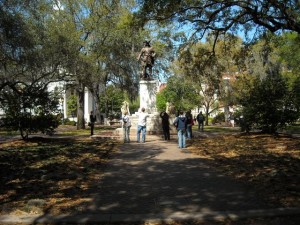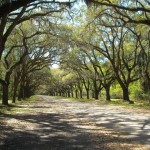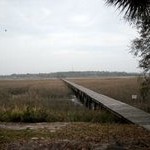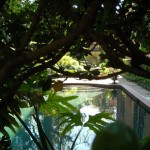The Sunday Drive ( a break from everything else)

Click to bigify images
The other day, while driving along Chapman, I was struck by the scrawny Bottle brush trees pruned to the point of embarrassment and disgrace. I’ve seen some of the worst examples of improper pruning of both trees and shrubs in Fullerton –both along boulevards and at private homes. Who are these morons with saws? I thought I’d share some of what I look forward to seeing when I go back.
Savannah is a cosmopolitan city with a mix of old and new. It’s an old city, one where history matters and has played a role in the shaping of it. One of the things that grabs the first time visitor are the trees. There are giant oaks draped with Spanish moss. The delicate but strong strands of moss takes over every thing from trees to camellias and azaleas. But the greenery seems to hold the entire city together giving it a level of comfort and sophistication.

There is a stately grandeur about these trees. Nowhere is this seen better than the oak alley planted along the road to Wormsloe Plantation. Wormsloe was built in 1740 by one of the original settlers, Noble Jones. What’s left of Savannah’s first fort are the “Tabby” ruins, a mixture of lime, sand, and oyster shell halves thrown in for good measure. While the ruins are interesting, it’s the alley that everyone remembers and associates with plantation landscapes.

One of my favorite finds was the discovery of two secret gardens. Secret meaning they’re private and I peeked through a fence. The two gardens shown here belong to townhouses along busy streets. They provide the owners respite in an area where funeral hearses are resurrected as tour buses, and the usual mix of tourists and business crowd the area.

Anyway, the grace of the trees and the way the moss takes over everything is part of what makes the city so beautiful. Further out, along the river, there is much scenery to take in as well. I find the natural landscape evocative of where I grew up. The bulrushes are beautiful as well. Here’s the dock over by a house we looked at to buy. This is the stuff of dreams as well.

missk, thanks for a lovely post. The problem in our city is that nothing is allowed to happen gracefully – over time – anymore. Everything is subjected to dopey masterplans that result in failed quick-fixes.
Take Harbor Blvd and the attempt to “beautify” it in the early 80s. A Redevelopment plan got rid of parking, put in those hideous silk floss trees, and a series of concrete spandrels to “unify” everything. Those people responsible should have been taken out and shot at dawn; instead they got promotions and kudos all around – despite their manifest failure. The spandrels were mercifully removed but the trees are still there two and a half decades later dropping their scrotum-shaped pod bombs on pedestrians – the ones that haven’t impaled themselves on the spikes or tripped over the broken sidewalks.
Fullerton’s “Main Street” has been little more than a traffic wind tunnel for 25 years with store entries off parking lots and alleys to the rear. The plan was a shameful failure that still bedevils Fullerton.
A quick look at the so-called SoCo (really just Santa Fe) area is great example of how an urban pioneer (the Continental) saw an opportunity in a lower-rent industrial setting to make a success. And then the Redevelopment folks moved in to put their stamp of approval on it with comical arches over the street, etc. – a sure receipe for sucking the authenticity out of the place.
Redevelopment is a menace to intelligent, gracious living. Ecrasez-l’infame!
Floss trees to our landscape are an usual addition. A native of South America, they are beautiful. I do think it lucky they are in the median rather than in the middle of a park or a playground.
However, I wonder why they chose this tree rather than a native oak. After all, there are 20 species of Quercus –one might have satisfied the redevelopment agency’s itch to add greenery.
The problem was the felt need to add street trees to a commericial street at all. The choice of tree was bad; the decision to have trees at all was disastrous. At the very most palms could have been added in the one and two hundred blocks to continue the theme started in the 300-400 blocks back in the 20s.
In the early 80s it became all too common for cities to buy into various revitalization programs to save their downtowns from the depredations of the malls. All sorts of nonsense was promoted and Fullerton went along with some of it. The idea of “unification” was an attempt to outmall the mall through uniformity, design guidelines, strict sign regulations and all other sorts of stuff that went against the very nature of the small town American Main St.
If you compare the images of harbor from the 50’s and now, it’s like getting smaked in the kisser.
Divine Miss K, we really enjoyed reading your post “the greenery seems to hold the entire city together giving it a level of comfort and sophistication”.
In our 17 year stint in Fullerton, not one decision made by the Fullerton city staff, and or the city council has displayed any level of sophistication, culture, style, composure, elegance, refinement, social grace, tact, urbanity, or wisdom.
Ignorance seems to hold Fullerton together, and as soon as our house is sold, C’est la vie!
I think there has to be a succession of things that happens to get people to spur some kind of movement. While the Fullerton Heritage group stands for one kind of very narrow definition of “historic,” there simply has to be more voices in order to help the city through the next phase of (for lack of a better word) growth. The questions it faces is: are we going to continue to build on the past, or are we going to look to the future? Is there a point where the two may co-exist, or does one have to obliterate the other. And since this is an attitude issue, can we change the pervading opinion that contemporary architecture is bad?
In other words, do we bend to stereotypes about the past –McSpanish architecture, a nostalgic reinterpretation of main street with kapok trees, the mass building of structures that all look the same, or do we take gambles and do things that push us forward?
A good example: In the 1950’s, there was a building in Savannah called Drayton Tower that stood in contrast to the historic 18th and 19th century architecture around it. People hated it. It was square, boxy, white –didn’t fit in at all. Ribbons of green windows sandwiched in between limestone. You can imagine: it stuck out like the proverbial sore thumb. Flash forward today, and Drayton tower is one of the prime examples of 50’s modern architecture and in 2005, the restoration began. They had a lot of crap to undo. But they have persevered and won.
Obviously, someone decided back then to take a risk and build something that was a testament to the times. It was a quality design to boot. 50 years later –the style is refreshing after a day of seeing an unending amount of wrought iron and crown mouldings. In fact, I’d love a modern mid-century home in Savannah. There aren’t many, but I am looking.
I’d just like to see Fullerton taking those same kinds of risks, and when those who are willing to do so come forward, not getting swatted down by the likes of those who insist on overfed versions of the original graceful Spanish-Mediterranean. Go take a look at any of the newer houses at the end of Skyline and what you see are homes on steroids. Or even the McSpanish touches on the Ralph’s/Subway/Chinese food strip mall over on Harbor. All are aberrations of the real thing.
Here is a suggestion: Do not, under any circumstances, vote for any city council candidate who has accepted campaign contributions from a developer.
“Go take a look at any of the newer houses at the end of Skyline and what you see are homes on steroids.”
Funny you should mention those houses. When that subdivision was approved design guidelines went with it: California Ranch Style houses were to be built. Of course the types of people who bought the lots were into something a little more grandiose and probably never read the fine print. The City’s Design Review Committee however still had to okiedokie those houses; Lo and behold! They miraculously discovered that two-story McMansions were ranch style!